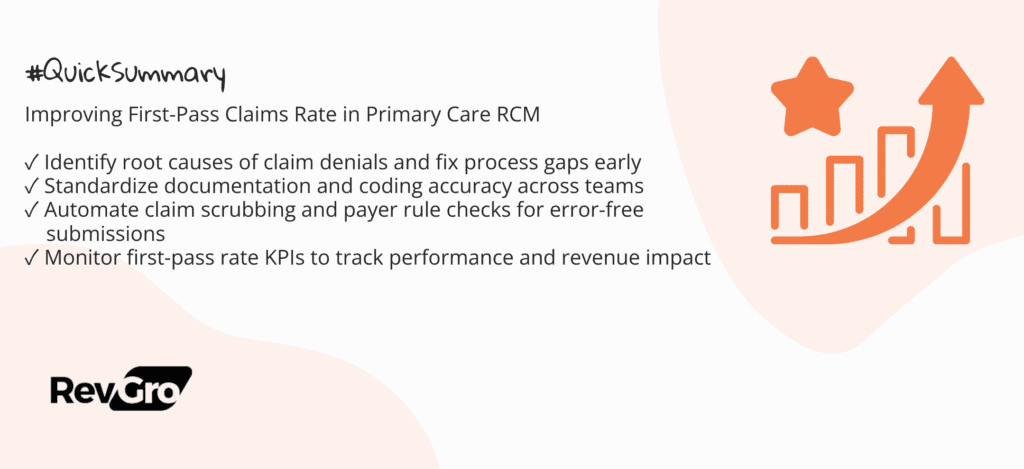
- Understanding First-Pass Claims Rate (FPCR)
- Key Factors Affecting First-Pass Claims Rate
- The ROI of Improving First-Pass Claims Rate
- Tactical Strategies to Improve FPCR in Primary Care
- Leveraging Technology and RCM Partnerships
- Executive Roadmap: Building a High-FPCR Culture
- Turning Claim Accuracy into Competitive Advantage

In the complex world of primary care revenue cycle management (RCM), one key performance metric stands out as a direct indicator of financial health — the First-Pass Claims Rate (FPCR). This metric measures the percentage of claims paid upon first submission without requiring edits, resubmissions, or appeals.
For primary care practices, improving this rate is not just about administrative efficiency — it’s about securing faster reimbursements, minimizing denials, and maintaining a steady cash flow. In this blog, we’ll explore what affects FPCR, why it’s vital, and the tactical steps leaders can take to improve it for sustained revenue performance.
Understanding First-Pass Claims Rate (FPCR)
The First-Pass Claims Rate refers to the proportion of claims that are successfully accepted and paid by payers the first time they’re submitted.
A high FPCR (95% or above) indicates an efficient RCM process, while a low FPCR means more claims are being denied or delayed — directly affecting revenue flow.
Why It Matters in Primary Care:
- Primary care practices often handle high patient volumes and lower reimbursement rates compared to specialties.
- Even minor claim errors can accumulate into substantial revenue leakage.
- An efficient FPCR helps stabilize cash flow, reduce administrative workloads, and enhance operational predictability.
Several operational inefficiencies can lead to a drop in FPCR. Understanding these root causes helps leaders target the right areas for improvement.
A. Incomplete or Inaccurate Patient Information
Simple data entry errors — such as missing policy numbers, outdated demographics, or incorrect payer details — are responsible for up to 42% of claim denials.
B. Coding and Documentation Errors
Primary care involves a wide range of visits, from preventive screenings to chronic care management. Missing documentation or inaccurate CPT/ICD-10 codes often trigger denials.
C. Lack of Eligibility Verification
Failure to verify insurance eligibility at the front desk leads to claim rejections for ineligible patients, which could have been prevented with proactive verification.
D. Delayed Charge Entry
If encounters aren’t coded and submitted promptly, practices risk missing payer deadlines — a leading cause of revenue loss.
E. Inefficient Denial Management
When denial patterns aren’t tracked or analyzed, recurring errors persist. This reduces FPCR and increases staff workload.
The ROI of Improving First-Pass Claims Rate
Improving FPCR directly impacts profitability and operational efficiency. According to 2025 RCM benchmarks:
- Practices with FPCR above 97% experience 15–20% faster reimbursements.
- Reducing rework by just 10% can cut administrative costs by $50,000+ annually for mid-sized primary care groups.
- Practices with optimized FPCRs report lower Days in AR (Accounts Receivable) — often under 30 days, compared to 45–60 for underperforming groups.
For executives, this isn’t just a billing KPI — it’s a financial performance lever.
Tactical Strategies to Improve FPCR in Primary Care
A. Strengthen Front-End Accuracy
Credentialed front-desk teams are your first defense against errors. Train staff to:
- Verify insurance eligibility in real-time using clearinghouse tools.
- Confirm demographic and payer details at every visit.
- Collect co-pays upfront and confirm patient balances.
Pro Tip: Automate eligibility verification to flag inactive or terminated policies before claims submission.
B. Invest in Coding and Clinical Documentation Excellence
Accurate documentation is the backbone of a clean claim.
- Regular coding audits can identify patterns of undercoding or miscoding.
- Use AI-assisted coding tools to flag missing information or mismatched CPT/ICD-10 combinations.
- Provide ongoing coding training to clinical staff and billers.
Leadership Insight: A 2025 AAPC study found that practices conducting quarterly coding audits improved FPCR by 8–12% within six months.
C. Implement Pre-Billing Quality Checks
Before claims are submitted, introduce a pre-billing audit process that reviews:
- Insurance verification
- Provider credentials
- Documentation completeness
- Code accuracy
This additional review layer can catch 90% of preventable denials before submission.
D. Automate Claim Scrubbing
Claim scrubbers automatically validate claims against payer-specific rules.
Automation here can:
- Detect missing NPI, modifier, or authorization codes
- Flag diagnosis/procedure mismatches
- Ensure payer-specific formatting compliance
Result: Practices using automated claim scrubbers report FPCR increases of 10–15% in under a year.
E. Strengthen Denial Analytics and Feedback Loops
Every denied claim holds insight. Use denial management dashboards to identify the root causes and trends across payers.
Actionable feedback should flow from the billing team to front-office and clinical staff to eliminate recurring issues.
Tracking metrics like Top 5 denial reasons and Payer-specific denial rates helps prioritize process improvements.
F. Prioritize Credentialing and Payer Enrollment
Even clean claims are useless if the provider isn’t credentialed correctly.
Ensure all primary care providers are credentialed and recredentialed on time across all major payers. Delays or lapses in enrollment can immediately impact FPCR.
Executive Tip: Centralize credentialing under RCM governance to synchronize payer readiness and claims workflows.
Leveraging Technology and RCM Partnerships
For high-performing primary care groups, technology-driven partnerships are becoming essential. Leading RCM partners offer integrated solutions that combine:
- Automated claim scrubbing and AI-powered denial prediction
- End-to-end credentialing and payer enrollment
- Analytics dashboards for real-time FPCR tracking
- Dedicated account management for payer follow-ups
Partnering with an experienced RCM firm like RevGroMD enables healthcare leaders to gain full visibility into their revenue cycle, reduce inefficiencies, and focus more on patient care.
Executive Roadmap: Building a High-FPCR Culture
Improving FPCR is not a one-time initiative — it’s a culture shift that requires continuous monitoring and accountability across departments.
Action Steps for Leadership:
- Establish FPCR benchmarks and review them monthly.
- Incentivize teams for achieving claim accuracy targets.
- Integrate RCM data into executive dashboards for real-time decision-making.
- Invest in training and automation to ensure long-term sustainability.
When the leadership team makes FPCR a strategic metric — not just an operational one — the entire organization becomes aligned toward efficiency and revenue optimization.
For primary care practices, improving this rate is not just about administrative efficiency — it’s about securing faster reimbursements, minimizing denials, and maintaining a steady cash flow. In this blog, we’ll explore what affects FPCR, why it’s vital, and the tactical steps leaders can take to improve it for sustained revenue performance.
Turning Claim Accuracy into Competitive Advantage
In an era where payer policies are becoming more complex and reimbursement pressures continue to rise, a high first-pass claims rate is one of the most reliable indicators of a financially healthy practice.
By improving accuracy, leveraging automation, and fostering cross-departmental accountability, primary care executives can ensure smoother revenue flow, stronger payer relationships, and faster growth.
At RevGroMD, we help healthcare organizations implement intelligent RCM systems that boost first-pass claim success, reduce denials, and drive measurable ROI.
Partner with RevGroMD to transform your claims process into a revenue-generating engine one clean claim at a time.
